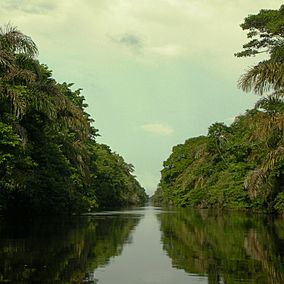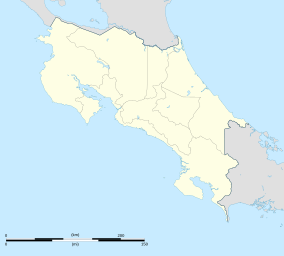Barra del Colorado Wildlife Refuge facts for kids
Quick facts for kids Barra del Colorado Wildlife Refuge |
|
|---|---|
 |
|
| Location | Costa Rica |
| Area | 200,600 acres (812 km²) |
| Established | 1984 |
| Governing body | National System of Conservation Areas (SINAC) |
The Barra del Colorado Wildlife Refuge is a special place in Costa Rica where wild animals and plants are protected. It's located in the northeastern part of the country, in Limón Province. This refuge is part of the larger Tortuguero Conservation Area. It's the second biggest rain forest area protected in Costa Rica! Here, you'll find hot, wet forests, mangrove swamps, winding canals, and even parts of the ocean. The refuge is bordered by the San Juan and Colorado rivers. It's also just south of the famous Tortuguero National Park.
Contents
What Makes This Place Special?
The Barra del Colorado Wildlife Refuge was created in 1984. It covers a huge area of about 200,600 acres (812 square kilometers). The main goal of the refuge is to protect the amazing plants and animals that live here. It's a very important place for nature.
Climate and Environment
This area has a very hot and wet climate. There is no dry season, which means it rains a lot all year round! This constant rain helps the rain forest grow thick and green. You'll find steamy, humid forests, and special mangrove trees that grow in salty water. There are also many natural canals and rivers.
Amazing Animals
The refuge is home to many different kinds of animals. Some are very rare!
- Mammals: You might spot the endangered West Indian manatee swimming in the waters. Other mammals include tapirs, powerful jaguars, speedy cougars, playful monkeys, and spotted ocelots.
- Reptiles: The rivers and canals are full of caymans and large crocodiles.
- Birds: Look up to see many kinds of birds! You could see osprey, colorful toucans, diving cormorants, elegant herons, and sharp-eyed hawks. Many other bird species also live here.
- Fish: The waters are also home to many types of fish.
Nearby Village
The village of Tortuguero is located right on the southern edge of the refuge. This village is also where the nearby Tortuguero National Park gets its name. There are two research stations in Tortuguero. Scientists study the wildlife and environment from these stations.
See also
 In Spanish: Refugio Nacional de Vida Silvestre Barra del Colorado (RNVSBC) para niños
In Spanish: Refugio Nacional de Vida Silvestre Barra del Colorado (RNVSBC) para niños


